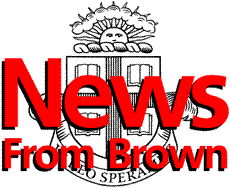
The Brown University News Bureau
1997-1998 index
Distributed November 4, 1997
Contact: Linda Mahdesian
Was it turkey or pheasant?
Lots of fowl - and five deer - were part of first Thanksgiving festivities
Facts about food from A Harvest Gathered: Food in the New World, the
current exhibition at the John Carter Brown Library, shows the variety and
range of food exchanges between the Old World and the New World, including a
description of the first Thanksgiving.
PROVIDENCE, R.I. -- The earliest description of the first Thanksgiving,
celebrated in 1621, mentions the Pilgrims feasting on "much fowl" but no
specific reference is given to turkey. However, the feast lasted three days,
during which time the Indian king Massasoit and some 90 of his men went out and
killed five deer and presented them to the governor of the colony and other
officials.
The above information is from Mourt's Relation: A Journal of the Pilgrims
at Plymouth, originally printed in 1622. The book is among dozens of
publications and illustrations from the exhibition, A Harvest Gathered: Food
in the New World, on display at the John Carter Brown Library at Brown
University through Jan. 10, 1998.
Here are some Thanksgiving tidbits from the exhibition:
- The potato was a food native to the New World and was introduced to the
Old World and eventually to Asia and Africa. The same goes for the sweet
potato, maize and manioc (also called cassava), as well as more exotic fare
such as the avocado, papaya, pineapple, tomato, chili peppers and cocoa.
- Nearly 30 percent of the plants currently cultivated throughout the world
originated in the New World.
- From the other direction, European plants accompanied settlers on their
voyages across the ocean. By 1500, Europeans were transforming the food supply
in the Americas, and by the beginning of the 17th century, all of the most
important European foods were being cultivated in the Americas.
- At the time of the Conquest, approximately 3,000 varieties of potatoes
were being grown in the Andean region of South America, where they have been
cultivated for more than four thousand years. Andean farmers also perfected the
first freeze-dried method of preserving potatoes.
- One difficulty in tracing the history of the potato's importation to the
Old World arises from an early confusion of names. The word first came into
English representing a different plant transported from the Caribbean, the
sweet potato. The word "batata," used by the Taino Indians of Hispaniola, and
pronounced "patata" by the Spanish, was transformed into "potato" by the
English. When the white potato from the Andes was introduced, it was also
called potato, although it belongs to an entirely separate taxonomic family.
- Maize production originated in southern Mexico and had spread throughout
pre-Columbian America by the time of the Conquest. Along with the potato, it
was a primary food of the Incas in Peru and an important staple in Mesoamerica
and North America as well.
- The settlers admired the skill and technique with which the natives hunted
deer in the northern woodlands. In the early 1600s, Jacques Le Moyne de Morgues
wrote: "Nowhere have we seen stag hunting as the Indians do it. They put
themselves inside the skins of the largest stags they have been able to kill,
so that their heads are in those of the animals. As with a mask, they see out
through the holes of the eyes. Thus dressed they can approach the deer closely
without frightening them."
- The breadfruit still is grown as a staple in the Pacific tropics and the
West Indies. The British naval vessel, "Bounty," under Captain William Bligh,
was transporting breadfruit plants to Jamaica when the famous mutiny led by
Fletcher Christian occurred in April 1789. Bligh finally succeeded in
introducing the fruit to the West Indies in January 1793.
- In Charles de Rochefort's The History of the Caribby-Islands,
published in London in 1666, the author describes catching turtles in the
Cayman Islands by surprising the creatures when they are laying their eggs and
turning them over onto their backs. He writes: "Being in that posture they are
not able to recover themselves, but continue so till the next day that they are
brought thence in Shallops to the Ships. When they are thus turned upside-down,
they are observ'd to shed tears, and are heard to sigh."
- Believed to be native to Ethiopia, coffee was introduced into Arabia by
the 15th century and from there spread to Egypt and Turkey. By the
mid-seventeenth century, it had reached most of Europe and soon thereafter was
introduced to North America, although it only surpassed tea as the preferred
American beverage after the latter fell out of favor following the Boston Tea
Party.
- D. de Quélus's Histoire naturelle du Cacao, et du sucre,
first published in Paris in 1719, includes descriptions of the cacao tree and
its cultivation as well as chapters on the uses and properties of chocolate.
Here the author discusses chocolate's ability to restore mental and physical
well-being: "For if a person, for example, fatigued with long and hard labor,
or with a violent agitation of mind, takes a good dish of chocolate, he shall
perceive almost instantly, that his faintness shall cease, and his strength
shall be recovered, when digestion is hardly begun."
Source: Exhibition catalog, A Harvest Gathered: Food in the New
World, prepared by Daniel J. Slive, coordinator of reader and bibliographic
services, John Carter Brown Library, Brown University.
######
97-034t

